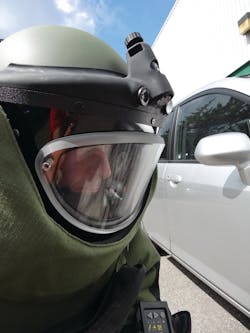Well-suited for explosions
Chris Cowan, a retired bomb squad commander, describes what it's like to don bomb gear
Descriptive Opening….
Chris Cowan is a retired bomb squad commander for the Winnebago County (Illinois) Sheriff's Department and current technical training representative with Med-Eng, a brand of the Safariland Group. Cowan has donned the ___ suit on a few occasions and recalls the physical, mental and emotion impact of the gear. In his experience, reports of possible IEDs (Improvised Explosive Devices) were often common in areas of high-crime/high gang activity.
"The area may be confined indoors or congested with garbage and obstacles outdoors making it impossible to use the robot or other tools. This is when it becomes necessary to send a highly trained bomb disposal technician, in a bomb suit, to make an approach and evaluate the situation," says Cowan.
After the area is secured and citizens are evacuated from the danger zone, well-equipped officers can go to work identifying what type of device he or she is dealing with and developing a course of action. The goal is always to conduct ‘Render Safe’ procedures as remotely as possible.
Cowan says IEDs come in many shapes and sizes and the fact that they’re improvised makes them fairly easy to make inexpensively, though this doesn’t take away from their lethal capability. Upon detonation there’s usually mass destruction, not to mention death and/or injury caused by blast overpressure, heat, fragmentation and impact.
The suit
Many components make up wearable bomb investigation equipment. This is what Cowan wore:
CC:If you’re dealing with an actual explosive device, the PPE (Personal Protective Ensemble) preferred is the Med-Eng EOD 9 bomb suit and associated equipment. For example, helmet cam/camcorder, breathing apparatus, visor, chemical protective under garment, body cooling system, and the thigh mountable HAL Tactical (Hook and Line Tactical Tool Kit).
If you’re dealing with a scenario that primarily involves a high risk search for an explosive device, then the preferred ensemble is the lighter weight TAC 6 suit.
The bomb suit with helmet weighs approximately 70 pounds while the TAC 6 with protective EOD chest plate and helmet weighs in at approximately 45 pounds. The helmet also has an integrated air circulation system which brings in outside ambient air through two particulate filters and circulates it throughout the helmet.
All this weight and full (encapsulation) can be disorienting.
“Technicians may initially feel the weight of the suit, but this is generally overcome due to its ergonomic design, proper training and good physical health,” says Cowan. The helmet visor is designed such that it doesn’t affect your vision and you have a normal field of view, including peripheral vision. Built-in EAS (Environmental Awareness System) and speakers in the ear pads of the helmet allow wearers to hear normal sounds and in the event of a high decibel sound, such as a blast event, the audio cuts off to protect your ears. The sense of smell is not affected because the helmet is not sealed around your neck.
Confined areas can present a challenge for getting around, this is generally overcome due to the ergonomic design, retractable groin plate, and proper donning and training.
What do suits protect against?
The bomb suit is designed to provide a high level of protection against the four main classifications of blast injuries:
Primary Blast Injury/Overpressure - caused by the direct effects of overpressure wave
Secondary Blast Injury/Fragmentation - caused by the effects of projectiles
Tertiary Blast Injury/Impact - caused by the effects of structural collapse and body translation
Quaternary Blast Injury/Heat - caused by the explosive fireball, gases, and toxic inhalants.

Sara Scullin
Sara Scullin was the Editor of Law Enforcement Technology magazine, a monthly business-to-business publication that covers technology trends and best practices for public safety managers. LET is part of SouthComm Law Enforcement Media, which also publishes Law Enforcement Product News and Officer.com. Sara had covered the law enforcement industry since March 2008.



